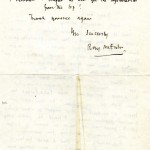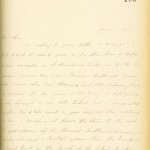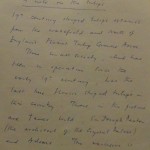It has been said that Rory McEwen was the finest British botanical artist of the Twentieth Century. There certainly has been no finer painter of the English Florists’ Tulip and he has been a great source of inspiration for a large number of artists who have approached the Society to obtain flowers to paint, since his death in 1982.
The great debt that the Society owes to him can be judged by entering McEwen (and also Sitwell) in the search facility on this site. A brief résumé of how he first became involved with the Society follows:-
In 1954 the Society was approached by the writer Sacheverell Sitwell for its help in the writing of a book about Florists’ Tulips for which Rory McEwen was to produce the paintings.

15 May 1954
We do not have this letter, but the response (shown right) by the Secretary Jim Akers read
15 May 1954
Dear Sir,
I thank you for your letter of 7th May. My society will be pleased to give you all the help it can. But the method of obtaining blooms to photograph which you suggest is to my mind unreliable with the Old English Tulip. I suggest you send your representative or come yourself to our show this year. You would be able to photograph the show blooms or take them with you after the show. You would meet the experts of this flower and would be able to acquire a great deal of information regarding the flowers.
Yours faithfully
J Akers.
The representative mentioned in the letter was in fact Rory McEwen to whom flowers were sent during the show season in the following year 1955.

25 May 1955

25 May 1955
Trinity College Cambridge
May 25th 1955
Dear Sir
I have received a large box full of tulips, I take it from you or your Society, for which I thank you very much. They were splendidly packed and arrived in excellent condition, all except James Wild who had rather a rough crossing. I am working on them now before they all die on me, and I would like to know two things.
First, what sort of leaves have these flowers got? I know the ordinary straight kind but I recollect, for instance, that Julia Farnese has leaves that go here follows a drawing of curly leaf. As these were just blooms, I wonder if there might be others among them with peculiar leaves. It would be rather a big job to paint all the leaves in again if I got it all wrong by painting from memory.
And secondly, is there a good history of old tulips on the market? I am getting more and more interested in them, and would like to know, for instance, how old they are, and whether the tulips in Thorntons Temple of Flora are any longer obtainable.
I am sorry to bother you in this way, but I reckoned I might as well get the information from the top!
Thank you once again.
Yrs sincerely
Rory McEwen
Jim Akers the Secretary responded as follows

5 June 1955
5th June 1955
Dear Sir,
In reply to letter of May 25th I had hoped to send you a further box of tulips of each varieties of Columbine Feather, Dr Hardy flamed, Annie McGregor flamed and Feathered, James Wild and some other rose flamed but the railway strike has ruined it.
The leaves of the English tulips are usually straight as in other tulips but in damp cold weather tend to curl as you suggest thus catching the rain and sending it down the stem to the root. The colour of the Flamed & Feathers leaves are usually streaked and lighter green than the breeders. A good book is The Book of the Tulip by Sir A Daniel Hall. The English tulip was first introduced about 1560.
Yours faithfully
J Akers.

Notes on Florists’ tulips and the Society
This undated note on Florists’ Tulips and the Society is produced by the kind permission of the McEwen family.
9 Tregunter Road
S W 10
Fremantle 6640
A note on the tulips
19th century striped tulips obtained from the Wakefield and North of England Florist Tulip Growers Assoc.
This small society, which has been in operation since the early 19th century has the last true florist striped tulips in this country. Those in the picture are James Wild, Sir Joseph Paxton (the architect of the Crystal Palace). The narcissus is of no particular botanical interest.
Painted on calfskin vellum.
Rory McEwen
Unfortunately the proposed book never came to fruition but the paintings still exist.
Rory maintained contact with the Society and in 1963 informed the Society that a painting had been presented to the White House in Washington. For details see here.